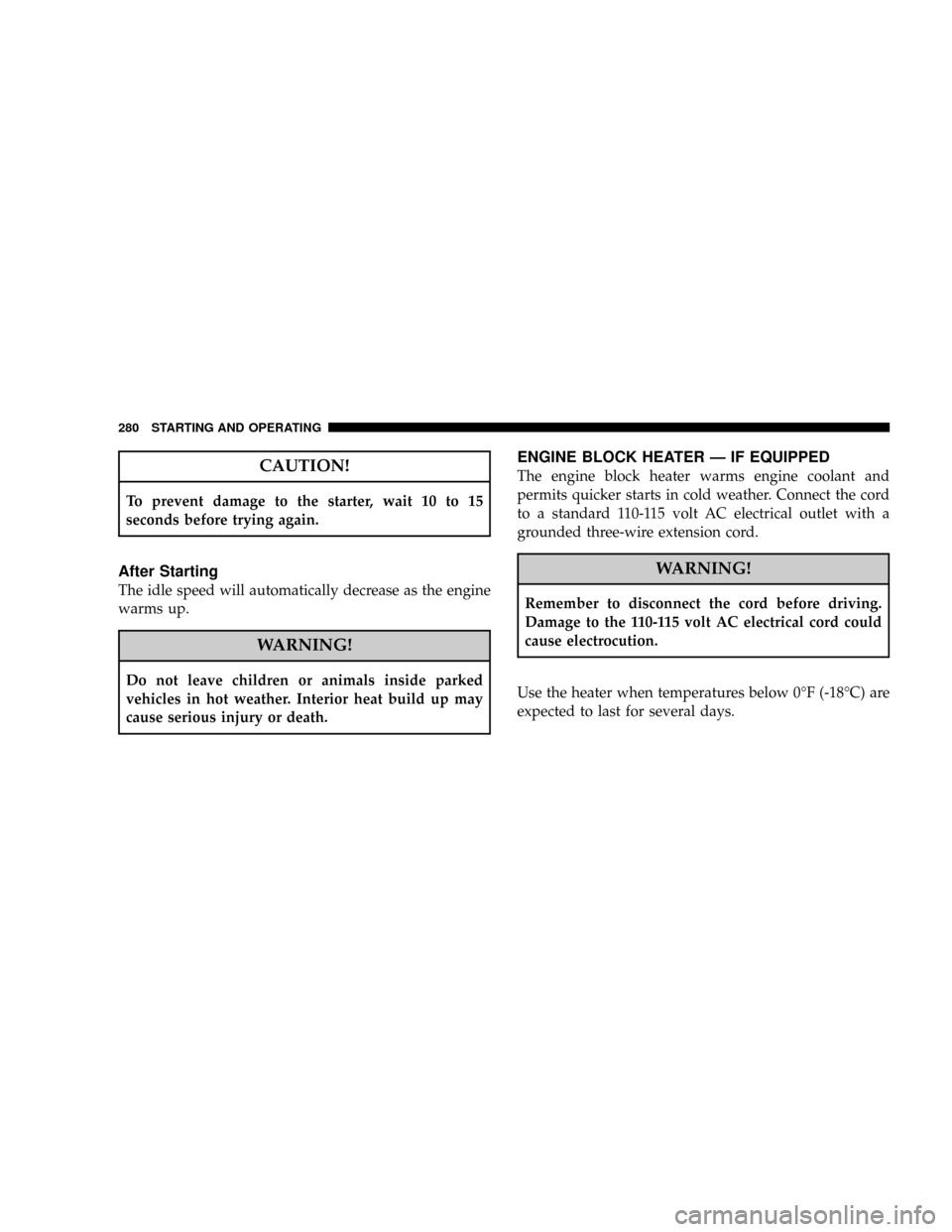2008 JEEP LIBERTY coolant temperature
[x] Cancel search: coolant temperaturePage 197 of 493

cluster comes on when the ignition switch is turned to the
ªONº position. It should go out with the engine running.
If the ªESP/BAS Warning Lampº comes on continuously
with the engine running, a malfunction has been detected
in either the ESP or the BAS system, or both. If this light
remains on after the several ignition cycles, and the
vehicle has been driven several miles at speeds greater
than 30 mph (48 km/h), see your authorized dealer as
soon as possible to have the problem diagnosed and
corrected.(See page 314 for more information.)
NOTE:The ªESP/BAS Warning Lampº comes on mo-
mentarily each time the ignition switch is turned ON.
NOTE:Each time the ignition switch is turned ON, the
ESP System will be ON even if it was turned off previ-
ously.
NOTE:The ESP Control System will make buzzing or
clicking sounds when it is active. This is normal; thesound will stop when the ESP becomes inactive following
a maneuver that caused the ESP activation.
21. SERV (Service) 4WD Indicator Light Ð If Equipped
The ªSERV 4WD Indicator Lightº will turn on
when the ignition key is turned to the ON
position and it will stay on for 2 seconds. If the
light stays on or turns on during driving, it
means that the 4WD system is not functioning properly
and that service is required.
22. Coolant Temperature Warning Light
This light warns of an overheated engine condi-
tion. If the light turns on while driving, safely pull
over and stop the vehicle. If the air conditioner is
on, turn it off. Also, shift the transmission into ªNº
(Neutral) and idle the vehicle. If the temperature reading
does not return to normal, turn the engine off immedi-
ately and call for service. (See page 384 for more infor-
mation.)
INSTRUMENT PANEL AND CONTROLS 197
4
Page 198 of 493

NOTE:As the coolant temperature gauge approaches
9H,9this indicator will illuminate and a single chime will
sound. Further overheating will cause the temperature
gauge to pass9H.9In this case, the indicator will flash
continuously and a continuous chime will sound, until
the engine is allowed to cool.
CAUTION!
Driving with a hot cooling system could damage
your vehicle. If the temperature gauge reads ªH,º
pull over and stop the vehicle. Idle the vehicle with
the air conditioner turned off until the pointer drops
back into the normal range. If the pointer remains on
the ªH,º and you hear continuous chimes, turn the
engine off immediately, and call for service.
WARNING!
A hot engine cooling system is dangerous. You or
others could be badly burned by steam or boiling
coolant. You may want to call a service center if your
vehicle overheats. If you decide to look under the
hood yourself, see Section 7 of this manual. Follow
the warnings under the Cooling System Pressure Cap
paragraph.
23. Coolant Temperature Gauge
The temperature gauge indicates engine coolant tem-
perature. Any reading within the normal range indicates
that the cooling system is operating satisfactorily. The
gauge pointer will likely indicate a high temperature
when driving in hot weather, up mountain grades, in
heavy traffic, or when towing a trailer. If the pointer rises
to the ªHº mark, safely pull over and stop the vehicle. If
198 INSTRUMENT PANEL AND CONTROLS
Page 280 of 493

CAUTION!
To prevent damage to the starter, wait 10 to 15
seconds before trying again.
After Starting
The idle speed will automatically decrease as the engine
warms up.
WARNING!
Do not leave children or animals inside parked
vehicles in hot weather. Interior heat build up may
cause serious injury or death.
ENGINE BLOCK HEATER Ð IF EQUIPPED
The engine block heater warms engine coolant and
permits quicker starts in cold weather. Connect the cord
to a standard 110-115 volt AC electrical outlet with a
grounded three-wire extension cord.
WARNING!
Remember to disconnect the cord before driving.
Damage to the 110-115 volt AC electrical cord could
cause electrocution.
Use the heater when temperatures below 0ÉF (-18ÉC) are
expected to last for several days.
280 STARTING AND OPERATING
Page 416 of 493

Cooling System
WARNING!
²When working near the radiator cooling fan, dis-
connect the fan motor lead or turn the ignition
switch to the LOCK position. The fan is tempera-
ture controlled and can start at any time the
ignition switch is in the ON position.
²You or others can be badly burned by hot coolant
or steam from your radiator. If you see or hear
steam coming from under the hood, don't open the
hood until the radiator has had time to cool. Never
try to open a cooling system pressure cap when the
radiator is hot.
Coolant Checks
Check engine coolant (antifreeze) protection every 12
months (before the onset of freezing weather, where
applicable). If coolant is dirty or rusty in appearance, the
system should be drained, flushed, and refilled with
fresh coolant. Check the front of the A/C condenser (if
equipped) or radiator for any accumulation of bugs,
leaves, etc. If dirty, clean by gently spraying water from a
garden hose vertically down the face of the A/C con-
denser (if equipped) or the back of the radiator core.
Check the engine cooling system hoses for brittle rubber,
cracking, tears, cuts, and tightness of the connection at
the coolant recovery bottle and radiator. Inspect the
entire system for leaks.
With the engine at normal operating temperature (but
not running), check the cooling system pressure cap for
proper vacuum sealing by draining a small amount of
coolant from the radiator drain cock. If the cap is sealing
416 MAINTAINING YOUR VEHICLE
Page 418 of 493

Adding Coolant
Your vehicle has been built with an improved engine
coolant that allows extended maintenance intervals. This
coolant can be used up to 5 Years or 100,000 miles (160
000 km) before replacement. To prevent reducing this
extended maintenance period, it is important that you
use the same coolant throughout the life of your vehicle.
Please review these recommendations for using Hybrid
Organic Additive Technology (HOAT) coolant.
When adding coolant:
²The manufacturer recommends using Mopart
Antifreeze/Coolant 5 Year/100,000 Mile Formula
HOAT (Hybrid Organic Additive Technology).
²Mix a minimum solution of 50% HOAT engine coolant
and distilled water. Use higher concentrations (not to
exceed 70%) if temperatures below234ÉF (237ÉC) are
anticipated.
²Use only high purity water such as distilled or deion-
ized water when mixing the water/engine coolant
solution. The use of lower quality water will reduce
the amount of corrosion protection in the engine
cooling system.
Please note that it is the owner's responsibility to main-
tain the proper level of protection against freezing ac-
cording to the temperatures occurring in the area where
the vehicle is operated.
NOTE:Mixing coolant types will decrease the life of the
engine coolant and will require more frequent coolant
changes.
Cooling System Pressure Cap
The cap must be fully tightened to prevent loss of
coolant, and to insure that coolant will return to the
radiator from the coolant recovery bottle.
418 MAINTAINING YOUR VEHICLE
Page 420 of 493

service attendant of this. As long as the engine operating
temperature is satisfactory, the coolant bottle need only
be checked once a month.
When additional coolant is needed to maintain the
proper level, it should be added to the coolant bottle. Do
not overfill.
Points To Remember
NOTE:When the vehicle is stopped after a few miles
(kilometers) of operation, you may observe vapor coming
from the front of the engine compartment. This is nor-
mally a result of moisture from rain, snow, or high
humidity accumulating on the radiator and being vapor-
ized when the thermostat opens, allowing hot coolant to
enter the radiator.
If an examination of your engine compartment shows no
evidence of radiator or hose leaks, the vehicle may be
safely driven. The vapor will soon dissipate.
²Do not overfill the coolant bottle.
²Check coolant freeze point in the radiator and in the
coolant recovery bottle. If coolant needs to be added,
contents of coolant recovery bottle must also be pro-
tected against freezing.
²If frequent coolant additions are required, or if the
level in the coolant recovery bottle does not drop when
the engine cools, the cooling system should be pres-
sure tested for leaks.
²Maintain coolant concentration at 50% HOAT engine
coolant (minimum) and distilled water for proper
corrosion protection of your engine, which contains
aluminum components.
²Make sure that the radiator and coolant recovery
bottle hoses are not kinked or obstructed.
420 MAINTAINING YOUR VEHICLE
Page 474 of 493

Temperature Gauge..................... 198
Corrosion Protection..................... 428
Crankcase Emission Control System.......... 409
Cruise Light........................... 202
Cup Holder............................ 172
Customer Assistance..................... 460
Data Recorder, Event...................... 67
Daytime Brightness, Interior Lights........... 139
Daytime Running Lights................... 135
Dealer Service.......................... 402
Defroster, Rear Window................... 181
Defroster, Windshield................82,262,268
Delay (Intermittent) Wipers................. 141
Diagnostic System, Onboard................ 399
Digital Video Disc (DVD) Player............. 237
Dimmer Control........................ 138
Dimmer Switch, Headlight................. 137Dipsticks
Oil (Engine).......................... 403
Disposal
Antifreeze (Engine Coolant)............... 419
Engine Oil........................... 405
Door Locks............................. 29
Door Locks, Automatic.................... 31
Door Opener, Garage..................... 155
Drive Belts............................ 406
Driving............................303,304
Off-Pavement......................... 304
Off-Road............................ 304
On Hills............................ 304
Through Flowing, Rising, or Shallow Standing
Water.............................. 304
When to Use Low Range................. 304
Electric Remote Mirrors.................... 90
Electrical Outlet, Auxiliary (Power Outlet)...... 169
474 INDEX
Page 478 of 493

Gauges
Coolant Temperature.................... 198
Fuel................................ 190
Odometer........................... 200
Speedometer......................... 194
Tachometer.......................... 195
Gear Ranges........................283,291
General Information...............17,26,118,355
General Maintenance..................... 402
Glass Cleaning.......................... 433
Gross Axle Weight Rating...............362,365
Gross Vehicle Weight Rating.............362,364
GVWR............................... 362
Hands-Free Phone (UConnectŸ)........92,237,239
Hard Drive (HDD)....................... 237
Hazard
Driving Through Flowing, Rising, or Shallow
Standing Water........................ 304Head Restraints......................... 122
Head Rests............................ 122
Headlights............................ 133
Automatic........................... 134
Bulb Replacement...................... 443
Cleaning............................ 432
Delay.............................. 134
High Beam/Low Beam Select Switch........ 137
Lights On Reminder.................... 135
On With Wipers....................134,143
Passing............................. 137
Replacing............................ 443
Switch.............................. 133
Time Delay.......................... 134
Heated Mirrors.......................... 91
Heated Seats........................... 123
Heater............................... 260
Heater, Engine Block..................... 280
High Beam Indicator..................... 193
478 INDEX